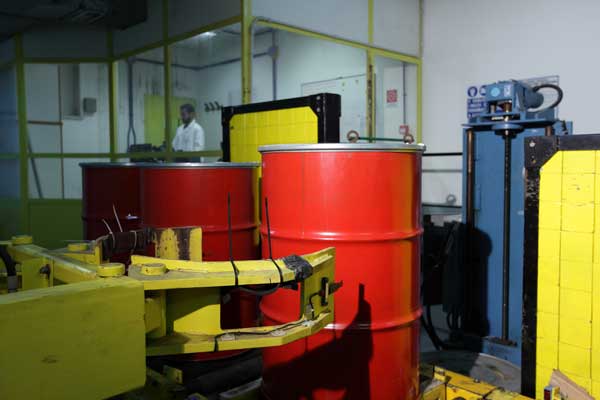Decommissioning
Sistema NIWAS (Nucleco Integrated Waste Assay System)
The Sogin Group uses the NIWAS integrated system (Nucleco Integrated Waste Assay System) for radiological characterization, which includes various independent measurement techniques aimed at quantifying the radiological content of a drum with the utmost precision and accuracy.
 Sistema NIWAS (Nucleco Integrated Waste Assay System)
Sistema NIWAS (Nucleco Integrated Waste Assay System)
In particular, the NIWAS system integrates the NWAS range spectrometry (Nucleco Waste Assay System) based on the segmented scanning system (Segmented Gamma Scanner), the passive and active neutron count measurement using the PANWAS system (Passive Active Neutron Waste Assay System) and the radiographic survey.
The results obtained with the listed techniques are integrated with the support of theoretical calculations and Monte Carlo simulations.
The Sogin Group is equipped with state-of-the-art measurement systems such as the Tomographic Gamma Scanner (TGS), which allows to reconstruct a 3D image of the matrix and of the contamination inside a drum.
The Geomixed system is instead used for measurements on packages of variable geometries, for their unconditional removal.
Portab
le spectrometers and Imaging system
The Sogin Group has over 20 portable HPGe detectors and CZT miniaturized detectors, a vast and cutting-edge technology park that allows you to choose, based on the operational and radiological complexity of the requested service, the optimal tools for the activities to be performed.
For the activities of radiological characterization with non-destructive techniques (NDA), Nucleco has equipped itself with an imaging system of gamma radiation, which allows to reconstruct the position and distribution of source of contamination in any type of room or object.
The Sogin Group provides technologies for the creation and study of 3D models, integrated in an analysis system called 3D SURVEY.
This system is based on the acquisition, with Laser Scanner systems, of “point clouds”, subsequently processed in 3D CAD models that allow to perform precision measurements and navigate through virtual reality systems in three-dimensional environments, in order to optimize the intervention planning phases.
Nucleco has used this technology to model its site, in order to reconstruct some plans of the plant
.
ICS42 Compaction and Dismantling Plant
In the ICS42 plant solid waste is treated at the Nucleco facilities. After an initial repackaging and sampling phase for a complete physical and radiological characterization, this waste is sent to the Compaction and Dismantling Plant. In the ICS42 plant, the 200-liter drums containing the waste are reduced in volume through a 1500-ton hydraulic press and other equipment that allows completely automated operations to be performed.
After compacting, the pellets produced are placed in special 400 liter metal containers, called Overpacks, designed and approved for transport. The Overpack content is inerted through a qualified and controlled cement mortar. The Overpacks are finally transferred to temporary depots, pending the availability of a final disposal site.
The plant is also equipped with a Pretreatment and Dismantling section thanks to which it is possible to dismantle contaminated components of various sizes, inside cells that are dynamically and statically confined, shielded and equipped with automated and remote cutting equipment (torch to plasma, manipulators, etc.).
The Pretreatment and Dismantling section consists of a pretreatment cell and a dismantling cell. In the pretreatment cell, the volumetric reduction of solid waste takes place, with a 200-ton hydraulic press, and its packaging in 200-liter drums to be sent to the characterization, treatment and conditioning process. The dismantling cell is instead dedicated to the volume reduction of large components by means of a remote cutting with a plasma torch.
Remote systems or robots for interventions in areas that are difficult to access
Robot for scarifying circular inner surface
s
Sogin designed, built and used a robot, equipped with the related tools, for scarifying the internal concrete surface of the chimney of the Garigliano nuclear power plant (91 meters) and for taking samples for decontamination progress checks.
This activity subsequently allowed the dismantling of the structure. To validate the entire system and perform the efficiency and reliability tests, a 12-meter high mock-up was created.
Dev
elopment of robots equipped with ultrasound probes for thickness measurements on stainless steel ta
nks
Sogin is designing a remote-controlled system that allows non-destructive tests to be performed, with particular attention to welding, on the outer shell of storage tanks for liquid radioactive waste made of stainless steel. The system must be able to move independently in an environment confined with high dose rates and with the problems associated with the non-magnetic characteristics of the tanks.
Since no commercial products are available, the technological solution being developed involves the construction of an integrated system consisting of a robot equipped with an articulated arm capable of supporting and positioning on the shell mantle a special ultrasonic probe, with axial sliding, capable of accurately perform thickness checks on the mantle and on the weld seams.